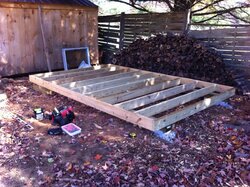I'm in the process of building a wood shed and had a few questions and I'm wondering what people think. Looking through some past threads it appears there is little consensus on anything  , but I thought I'd ask and see what people think.
, but I thought I'd ask and see what people think.
Shed is 8'x12'. I've used PT2x6 as joists, sitting on two PT4x6 skids atop concrete blocks. I'm in the process of figuring out what to do with the flooring. I plan on using PT decking 5/4x6, but was thinking whether there were benefits of leaving a couple of inches gap between each board for air circulation, or should I just deck the whole thing? I'm wondering whether the additional air flow is counteracted by upward movement of moisture from the ground. Thoughts?
Next issue is whether I actually have side walls on the structure. I definitely want a back wall, but was either thinking of half walls on the side, or full walls, again with sizable gaps between to allow air flow. With enough overhang on the roof, do I really need walls at all?
Finally, what do I stack in the shed? This years burning wood (already seasoned) or wood that requires seasoning? I don't have too much space, so additional rows outside of the shed may be problematic to some degree. The opening of the shed is west facing. My initial thoughts are to simply put the current years burning wood in the shed (keeping it out of the snow and rain), and have the rest seasoning outside of the shed, but my better half may not like that too much. Then, in late summer/early fall move the seasoning in for burning. I guess it's possible to have a rotation system of some kind - as space opens up fill with new wood? What are people experiences with this kind of thing?
Would appreciate any feedback. I've attached an image of the floor structure as it currently stands.

 , but I thought I'd ask and see what people think.
, but I thought I'd ask and see what people think.Shed is 8'x12'. I've used PT2x6 as joists, sitting on two PT4x6 skids atop concrete blocks. I'm in the process of figuring out what to do with the flooring. I plan on using PT decking 5/4x6, but was thinking whether there were benefits of leaving a couple of inches gap between each board for air circulation, or should I just deck the whole thing? I'm wondering whether the additional air flow is counteracted by upward movement of moisture from the ground. Thoughts?
Next issue is whether I actually have side walls on the structure. I definitely want a back wall, but was either thinking of half walls on the side, or full walls, again with sizable gaps between to allow air flow. With enough overhang on the roof, do I really need walls at all?
Finally, what do I stack in the shed? This years burning wood (already seasoned) or wood that requires seasoning? I don't have too much space, so additional rows outside of the shed may be problematic to some degree. The opening of the shed is west facing. My initial thoughts are to simply put the current years burning wood in the shed (keeping it out of the snow and rain), and have the rest seasoning outside of the shed, but my better half may not like that too much. Then, in late summer/early fall move the seasoning in for burning. I guess it's possible to have a rotation system of some kind - as space opens up fill with new wood? What are people experiences with this kind of thing?
Would appreciate any feedback. I've attached an image of the floor structure as it currently stands.


